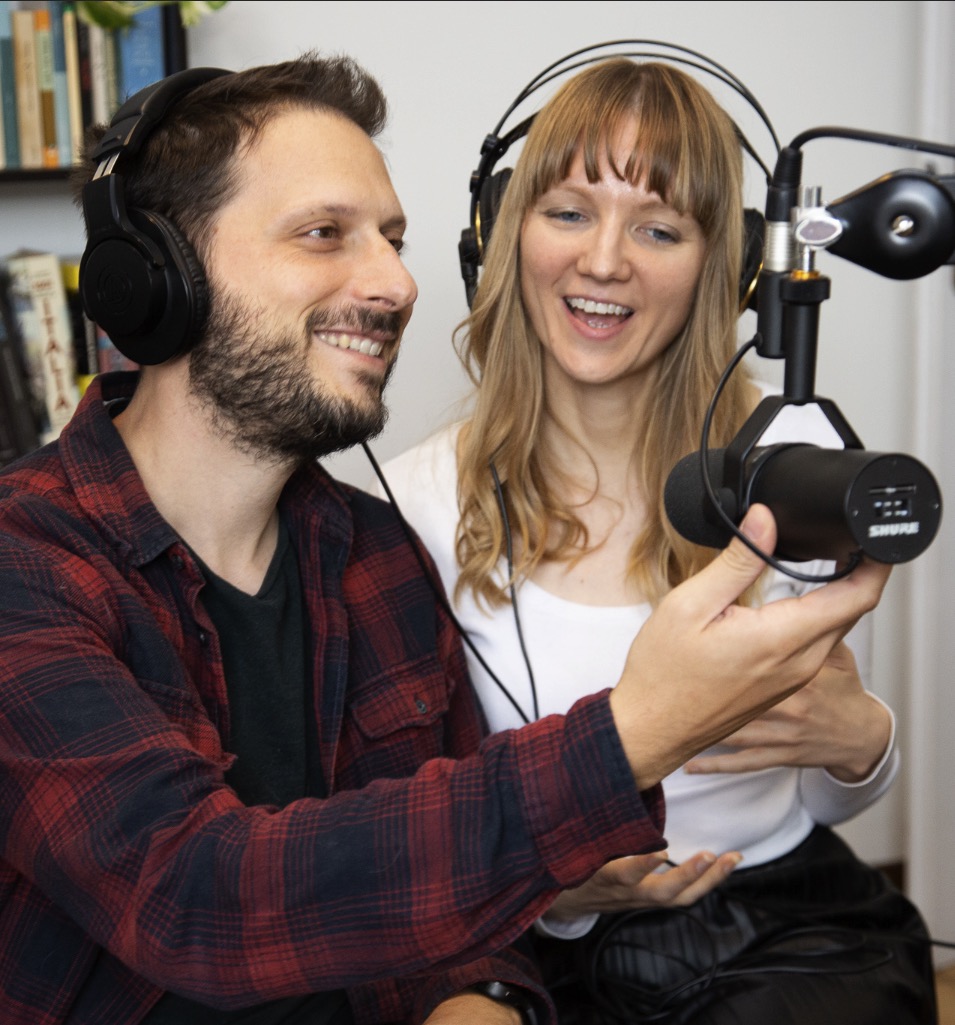 After Francesca's lessons, I fell in love with learning Italian because I realised that I could learn it by socialising!
After Francesca's lessons, I fell in love with learning Italian because I realised that I could learn it by socialising!If you want to have conversations in Italian, you need lots of speaking practice
The idea is simple, but the reality is hard.- What if you forget a word and get stuck mid-sentence?
- Or you say everything perfectly, but don’t understand the reply?
- Or you get really nervous and your brain freezes up?
- How can you find Italians to practice with?
- Won’t people get impatient if you speak too slowly?
- What if people keep replying in English?
- The nuts and bolts of Italian conversation: basic greetings, simple questions and small talk
- How to stop people from replying in English.
- Where to find speaking partners to practice with.
 If you'd like to be involved, click here to find out more about our Italian immersion vacations.
But for now, let's learn how to have a conversation in Italian.
If you'd like to be involved, click here to find out more about our Italian immersion vacations.
But for now, let's learn how to have a conversation in Italian.
Get ready to have a conversation in Italian
The fastest way to prepare for Italian conversations is to learn words and phrases that are likely to come up in everyday conversation. This means going against the traditional classroom way of learning languages: you don’t need to memorise all the rooms in a house, or names of sports before you can start having conversations with Italians. In this section, you’ll learn key Italian conversation skills such as:- Basic greetings and pleasantries
- Asking and answering small talk questions
- Talking about yourself in Italian
- Stopping people from replying in English
- Managing communication breakdowns
Managing communication breakdowns: The 6 most important phrases you’ll ever need in Italian
When people say they’re nervous about speaking a foreign language, usually they’re not scared of speaking it (that’s the goal!), they're nervous about all the things that could go wrong, such as:- Long silences
- Embarrassing mistakes
| Come si dice questo in italiano? | How do you say this in Italian? |
| Che cosa vuol dire questo in italiano? | What does this mean in Italian? |
| Scusi, non ho capito* Scusa, non ho capito | Sorry, I didn’t understand (formal) Sorry, I didn't understand (informal) |
| Potrebbe ripetere, per favore? Puoi ripetere, per favore? | Could you repeat, please? (formal) Can you repeat, please? (informal) |
| Potrebbe parlare più lentamente per favore? Puoi parlare più lentamente per favore? | Could you speak slower please? (formal) Can you speak slower please? (informal) |
| Possiamo parlare in Italiano per favore? Vorrei imparare. | Can we speak in Italian please? I’d like to learn. |
Learn basic greetings in Italian (+ other pleasantries)
First things first - let’s start with names. The easiest (and most natural way) to introduce yourself to someone is to shake their hand and say:- Sono… [+ your name]
- Sono Katie (I'm Katie)
- Sono Matteo (I'm Matteo)
- Come ti chiami?
- Come si chiama?
Learn how to ask and answer simple conversation questions in Italian
Once you've learnt the basic pleasantries, it’s time to pick up some common conversation questions in Italian. As in English, the first two questions that are most likely to come up in conversation are:- Di dove sei? Where are you from?
- Che lavoro fai? What job do you do?
- Di dov’è? Where are you from (formal)
- Che lavoro fa? What job do you do (formal)
Di dove sei? (where are you from?)
The simplest way to tell people where you're from is to use "sono" (I am) + your nationality. For example:- Sono americano (I’m American - for males)
- Sono australiano (I’m Australian - for males)
- Sono italiano (I’m Italian - for males)
- Sono americana (I’m American - for females)
- Sono australiana (I'm Australian - for females)
- Sono italiana (I’m Italian - for females)
- Sono inglese (I’m English - for males and females)
- Sono scozzese (I’m Scottish - for males and females)
- Sono francese (I’m French - for males and females)
- Sono di Londra (I'm from London)
- Sono di New York (I'm from New York)
- Sono di Roma (I'm from Rome)
Che lavoro fai?
To describe your job, use "sono" (I am) + your job. For example:- Sono insegnante (I'm a teacher - for males and females)
- Sono in pensione (I'm retired - for males and females)
- Sono impiegato (I'm an office worker - for males)
- Sono impiegata (I'm an office worker - for females)
- Sono studente (I'm a student - for males)
- Sono studentessa (I'm a student - for females)
Learn how to talk about yourself in Italian
When you meet Italian people, they'll probably ask you about yourself and your interests. It helps to have some pre-prepared soundbites so you can talk about these topics without having to stop and think too much. One way to do this is to memorise a paragraph or two with basic personal information. Some ideas for topics that will come up frequently are:- Your hometown/country
- Your job
- Your family
- Why you’re learning Italian
- Your opinion of Italy and Italians (Italians love to ask this!)
How to make small talk in Italian
The stereotype is true - Italians love to talk about food! Learning how to talk about food will give you a great basis for light conversation in Italian. Here are some good questions to ask.- Quali sono i piatti tipici della tua regione? What are the typical dishes of your region?
- Mi puoi suggerire alcuni ristoranti buoni? Can you recommend any good restaurants?
- Ti piace cucinare? Do you like cooking?
- Che cosa ti piace cucinare? What do you like cooking?
- Che tipo di vino ti piace? What kind of wine do you like?
- Mi puoi suggerire un buon vino? Can you recommend a good wine?
- Preferisci la pizza napoletana o romana? Do you prefer Neapolitan pizzas (soft with thick crusts) or Roman pizzas? (thin and crispy)
- Quali sono i piatti tipici della SUA regione? What are the typical dishes of your region?
- Mi PUÒ suggerire alcuni ristoranti buoni? Can you recommend any good restaurants?
- LE piace cucinare? Do you like cooking?
- Che cosa LE piace cucinare? What do you like cooking?
- Che tipo di vino LE piace? What kind of wine do you like?
- Mi PUÒ suggerire un buon vino? Can you recommend a good wine?
- PREFERISCE la pizza napoletana o romana? Do you prefer Neapolitan pizzas (soft with thick crusts) or Roman pizzas? (thin and crispy)
- Adoro + food name (e.g. adoro la burrata = I love burrata)
- Lo adoro! I love it!
- Che buono! How tasty!
- È molto buono.It's really tasty!
- Mi piace molto. I really like it
 Bringing up the Rome vs. Naples pizza debate will get Italians talking for hours (Just in case you were wondering - Naples pizza, obviously).
Bringing up the Rome vs. Naples pizza debate will get Italians talking for hours (Just in case you were wondering - Naples pizza, obviously).It's also handy to learn some phrases to talk about food from your region because Italians will almost certainly ask you about this sooner or later.
- Il piatto tipico della mia regione è... The typical dish of my region is...
- Di solito mangiamo... Normally we eat...
- È un tipo di... It's a type of...
- Si fa con… It’s made with…
How to talk about the weather in Italian
Another classic small talk topic is the weather - Italians talk about it just as much as British people do! Here are some handy phrases:- Fa caldo oggi It's hot today
- Fa caldissimo! It’s really hot!
- Fa freddo oggi It's cold today
- Fa freddissimo It's really cold!
- Fa freschetto Literally, it’s a bit fresh - often used in summer when it’s not as hot as expected, or at the end of summer, when it starts to get cooler).
Your own small talk topics
The best small talk topics draw from your own interests: if you love football, why not learn a few questions to chat about Italian teams? If you’re into music, asking about classic Italian bands would be a great way to get Italians talking. Related post: 9 catchy Italian songs to learn Italian (+ lyrics and translations) Once you find a speaking partner to practice with, you can ask them to teach you some phrases to help you talk about your favourite topics in Italian.How to stop people from replying in English
You finally pluck up the courage to try speaking Italian, then something frustrating happens... They reply in English! Getting Englished is a common problem for language learners and it can knock your confidence before you’ve even started. Keep in mind that the reason Italians reply in English often has nothing to do with your language skills. I’ve been living in Italy for 7 years and my Italian is pretty good, but people still reply to me in English at times. Italians normally speak English to foreigners for the following reasons:- They’re trying to be nice - they assume you’d rather speak English because it’s easier.
- They’re working in a busy bar or restaurant and assume it will be quicker to use English.
- They serve foreigners all day and use English out of habit.
- They want to practice their English!
1. Have the first phrase ready in your head
You get to the front of the queue, your mind goes blank and errrhm… errrhm… errrhm... Before you get your sentence out, the server has switched to English. Deciding what to say and getting the phrase ready in your head will help you deliver it smoothly and increase your chances of getting a reply in Italian.2. Sound confident
We've already seen that “non ho capito” (I don’t understand) is best avoided in isolation because it gives the listener a chance to jump in and start speaking English. Sometimes, it’s better to say:“Non ho sentito, puoi ripetere?” I didn’t hear, can you repeat?
Italians will be less likely to switch to English when you use this phrase because you sound more confident - it’s not that you didn’t understand, you just didn’t hear ;) Another handy phrase is:“Non mi viene la parola” The word doesn’t come to me
This is a phrase Italians use when they momentarily forget a word. When you say it, Italians will assume that you normally know the word, you just forgot it for a second! You can learn more phrases like these in our free webinar: 19 essential phrases to keep the conversation going and sound more fluent when you speak Italian
The webinar is hosted in our private Facebook group - click on join and we’ll let you in asap.
19 essential phrases to keep the conversation going and sound more fluent when you speak Italian
The webinar is hosted in our private Facebook group - click on join and we’ll let you in asap.
3. Look Italian
If an Italian can tell that you’re a foreigner from your appearance, they’ll probably start speaking to you in English. You can reduce your chances of this happening by observing and copying Italians:- What do they wear?
- How do they move?
- What do they say in certain situations?
- Dress smartly - Italians like to keep it formal and rarely wear sportswear outside the house or gym. You'll see some denim and trainers, but they’re generally smart or put together in a fashionable way. You’ll also see lots of leather jackets and sunglasses!
- Avoid showing too much skin - Italians rarely wear skimpy clothes. Even in very hot weather, they opt for long and flowing rather than short and skimpy to stay cool.
- When you walk into a shop, it’s polite to say “buongiorno/buonasera” to the staff when you enter and “arrivederci” when you leave. With young staff in informal shops, you can use “ciao”.
- Don’t drink cappuccinos or lattes after midday - they’re considered a breakfast drink in Italy.
- Don’t order wine with pizza - the traditional Italian combo is pizza + beer.
 Italians never drink milky coffee like cappuccinos or lattes after midday - they're considered a breakfast drink in Italy.
Italians never drink milky coffee like cappuccinos or lattes after midday - they're considered a breakfast drink in Italy.4. Avoid big cities
If you get the chance, visit small towns that aren't popular tourist destinations. You'll be less likely to run into Italians who speak English, which will give you a great opportunity to practice your Italian.5. Ask people to speak Italian with you
If you’re a native English speaker, it's doubly hard to learn Italian because you'll find lots of Italians who want to practice their English with you. Over the years, I’ve learnt that the best way to deal with this problem is to simply ask:Possiamo parlare in italiano? Vorrei imparare.
Can we speak in Italian? I’d like to learn.
Once you’ve explained the situation, most Italians will be happy to chat with you for a little while in Italian. That said, in the early days, it’s not always practical to insist that people speak Italian with you, as the conversation might be slow and stunted. When you’re just starting to speak Italian, it's better to practice in situations where there's a “learning agreement”.5. Set up an Italian “learning agreement”
Speaking with random people in shops/restaurants/public transport can feel intimidating because:- You don’t know the person
- There's pressure to have a normal conversation, which might make you might feel embarrassed about mistakes and long pauses (a completely normal part of language learning!)
- An online language tutor
- A language exchange partner
- Our Italian immersion vacations.
Get feedback from native Italian speakers
Some people think that speaking a foreign language is like a performance. You practice alone for months or even years, then, once you've mastered enough, you can unveil your skills to native speakers. But languages don’t work like that. They're more like Bambi learning how to walk: you have start by making lots of mistakes and looking a bit silly. https://twitter.com/Joyoflanguages/status/1049721591234482178 Don’t try to hide the fact that you’re learning. Treat mistakes as normal and ask for corrections as you go along. The following phrases will help you ask for feedback in Italian so you can check that what you're saying is correct and learn from your mistakes.- Si dice così? Do you say it like that?
- L’ho detto bene? Did I say it right?
- È corretta la frase? Is the sentence correct?
Learn the Italian “thinking sounds”
When you start having conversations in Italian, it's normal to have epically long pauses while you search your brain for words and combine them into grammatical sentences. When this happens, it's useful to have some Italian “thinking words” because they will help you sound more Italian when you pause.The Italian “ehhhh”
Every language has it's own “thinking sound”. In English, we say “uhm” a lot. In Italian, it’s more of an “ehhhh” sound. Switching "uhm" to "ehhhh" is a simple trick, but it instantly makes you sound more Italian.Tipo..
This is… like... the Italian equivalent to saying “like”, “kind of”, or “sort of” in English. But a bit less annoying.Diciamo…
Let’s say….Come dire…?
How can I put it...? (literally: how can I say it) To learn more words and phrases like these, check out our free webinar: 19 essential phrases to keep the conversation going and sound more fluent when you speak Italian
It's hosted in our private Facebook group - click on join and we’ll let you in asap.
19 essential phrases to keep the conversation going and sound more fluent when you speak Italian
It's hosted in our private Facebook group - click on join and we’ll let you in asap.
Read and listen to things that will help you have better conversations in Italian
It's difficult to have meaningful conversations in Italian by memorising phrases alone. You also need to get lots of exposure to the Italian language through reading and listening, so you can start to absorb common words, phrases and grammatical structures. When you read and listen to Italian regularly, things will often “pop into your head” when you need them, helping you speak in a more fluid way. Here’s an article with 38 resources to help you learn Italian. In it, you’ll find lots of tools to help you start reading and listening to Italian. The best 38 resources to learn Italian: from beginner to advancedHow to have your first conversation in Italian
You’ve got the basic greetings and small talk down, you know how to talk about yourself and manage communication breakdowns and you’re doing lots of reading and listening. You’re ready for your first conversation in Italian. Nervous?What to do if you feel nervous about speaking Italian
Whatever you do, don't try not to feel nervous about speaking Italian. It’s a bit like trying not to think of a pink elephant. If I ask you not to think of a pink elephant, what's the first thing you think of? Nerves are the same - the harder you try not to feel nervous, the more nervous you feel!
If I ask you not to think of a pink elephant, what's the first thing you think of? Nerves are the same - the harder you try not to feel nervous, the more nervous you feel!It's not possible to “think yourself out of” feeling nervous. The more you try, the more you focus on your nerves and the worse they get. Besides, a bit of nervousness is a good thing - it’s a sign that you’re about to do something exciting that will help you grow. The key is to start slowly and do something that gives you the right level of nervousness - think dipping your toe out of your comfort zone, rather than pole vaulting out of it. Once you get used to doing that, try something else that makes you a bit nervous.
 The virtuous circle of confidence: To get comfortable speaking Italian, start with something that's a teeny bit outside your comfort zone. Once you're used to doing that, try something else. If you keep inching forward like this, one day you'll look back and surprise yourself with how far you've come.
The virtuous circle of confidence: To get comfortable speaking Italian, start with something that's a teeny bit outside your comfort zone. Once you're used to doing that, try something else. If you keep inching forward like this, one day you'll look back and surprise yourself with how far you've come.Follow this cycle and you’ll make sustainable progress in speaking Italian without traumatising yourself. Next, you'll find a few suggestions for how to gently nudge yourself out of your comfort zone and build up to having conversations in Italian.
Warm up by chatting in Italian online
Chatting online in Italian is a great way to ease yourself into real Italian conversations. People can’t see your face (unless you want them too) and the writing format gives you plenty of time to think about what you want to say. You can even use an online dictionary to find the right words as you chat. Here are a few resources you can use to practice your Italian online:HelloTalk
HelloTalk is a bit like WhatsApp for language learners. You can use it to find native Italian speakers and do a language exchange via text messages. There are built-in tools to help you learn during your conversation, such as a translation button, which helps you understand the Italian messages. Once you get used to texting, you can practice speaking by sending audio messages (just like WhatsApp) and setting up video exchanges.Follow Italian teachers online
There are some brilliant Italian teachers with online communities that chat together in Italian. Why not join them and practice your Italian by writing in the comments? Two of my faves are:Join the Language Diary Challenge
Another great way to practice your Italian online is to join the language diary challenge.To take part, all you have to do is post a photo or video and write/say something in Italian every day for 30 days. It’s a great way to get daily practice in Italian and meet a fab community of language learners (you might even win a prize at the end!) You can join via Instagram or Facebook The Language Diary Challenge on Instagram Join the Language Diary Challenge Facebook community
Chat with us in the Five Minute Italian Facebook group
Inside the 5 Minute Italian Facebook group, you’ll find conversation questions to practice your Italian, cultural tidbits and a lovely bunch of Italian learners. At the moment it’s private to give you a safe space to practice using your Italian - click on join and we'll let you in!Practice speaking Italian without native speakers
Did you know that there are lots of ways to practice speaking Italian before you meet native speakers? This post has 4 ideas.4 unconventional ways to practice speaking without a native speaker
Where to find Italian speaking partners
Time for the real thing: having a conversation with a native Italian speaker. Don't fall into the trap of putting this off until you feel more confident - that day may never come! Remember, the best way to feel more confident speaking Italian is to practice speaking Italian. Your speaking partner is there to help you learn, so there’s no pressure to be perfect. Give yourself permission to be a beginner and embrace your mistakes. All you have to do is keep practicing and one day you’ll be speaking Italian like a pro.italki
On italki, you can book private conversation lessons with native Italian speakers called “community tutors”. It’s my favourite way to practice speaking a foreign language because:- The lessons are great value (sometimes less than $10 per hour).
- It’s a private lesson, so you get way more speaking practice compared to normal classes.
- You can book a lesson at a time that suits you.
- You can speak to native Italian speakers from wherever you are in the world!
Conversation exchange
If you prefer face-to-face chats, try conversation exchange to find native speakers who live in your area. If you're in Italy, you can use conversation exchange to meet locals who will help you practice speaking Italian and show you the places they normally hang out. I did this in Paris and it was great - like having a teacher and a local tour guide all rolled into one!Italian immersion vacations
 A fast and fun way to improve your Italian speaking skills is to join our next immersion vacation in Italy. In these vacations, we give you as much Italian speaking practice as possible so you can make a huge jump in your speaking skills after only a few days.
You’ll get:
A fast and fun way to improve your Italian speaking skills is to join our next immersion vacation in Italy. In these vacations, we give you as much Italian speaking practice as possible so you can make a huge jump in your speaking skills after only a few days.
You’ll get:
- Full Italian immersion in beautiful locations.
- Patient Italian teachers who encourage you to speak.
- New friends to speak Italian with!




